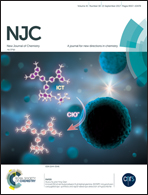Photophysical properties of quinoxalin-2(1H)-ones: application in the preparation of an azide-based fluorogenic probe for the detection of hydrogen sulfide†
Abstract
Quinoxalinones are widely exploited for their biological activities, but more rarely for their fluorescence behavior, partly due to a lack of data. Herein, we investigated the photophysical properties of selected 3-benzoylquinoxalin-2-ones and their NaBH4-reduced products, obtained by the rearrangement of benzodiazepin-2-ones. To illustrate their potential, a quinoxalinone-based chemoprobe for the specific detection of hydrogen sulfide was investigated.



 Please wait while we load your content...
Please wait while we load your content...